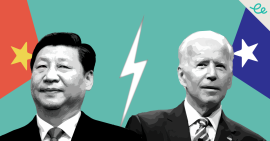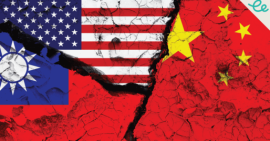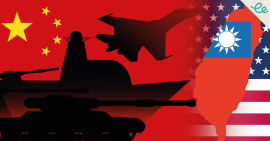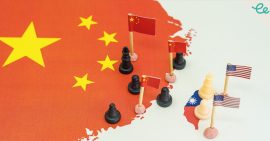China’s ever-growing military might make the possibility of China Taiwan invasion the biggest geopolitical risk facing investors.
China to Taiwan – given China’s growing military power, a potential armed conflict poses the greatest geopolitical risk for investors.
And the latest news from the troubled Taiwan Strait offers little hope that both sides can avoid a China Taiwan war. Also that Taiwan could resist invasion, even with US support.
On January 11, Chen Yi, 28, the Taiwanese pilot of an US-made F-16V fighter, completed a series of simulated missile launches before his Lockheed Martin jet abruptly nosedived into the sea off the island’s southwest coast. Chen’s death marked the latest tragedy in at least eight major accidents involving F-16s in Taiwan since 1998.
President Tsai Ing-wen asked the defence ministry to swiftly investigate the cause of the crash. This dealt a blow to Taiwan’s hopes of using its most advanced warplanes to beef up its aging fleet and boost defence against rising threats from Beijing. Captain Chen’s family performed a “soul summoning” folk ritual, on the shore near the crash site, to call for his soul’s return home.
In Beijing, Zhu Fenglian, a spokesperson for the State Council’s Taiwan Affairs Office, dismissed the Taiwan government as “not knowing its abilities” in trying to seek independence by force. “It will not only seriously damage the well-being of the Taiwanese people, but will also exacerbate tensions and turmoil in the Taiwan Strait, pushing the Taiwanese people into a dangerous situation,” she said.
”Surrender now!”
Those tensions were hardly calmed by a viral propaganda video aimed squarely at Taiwan by China’s People’s Liberation Army. “Surrender now! Hand in your weapons and you won’t be killed. We treat prisoners well!” promised the narrator over footage of a large-scale training exercise dated January 4. “Your defences have collapsed; resistance is futile,” she said in Mandarin Chinese but also in Hakka and Minnan, two dialects spoken by over half Taiwan’s population.
The threat from China is “very serious”, Minister of Foreign Affairs Joseph Wu warned on 14 January, the day Chen’s body was formally identified. “We have the responsibility of defending ourselves”, and cannot rely on the US alone to defend Taiwan, he told France24.
Mainland pressure is rising too, said Wu. “If you look at the level of their military exercises around Taiwan, either in the air or on the surface, or their missile capabilities, [the Chinese military] is being improved tremendously in the [past] few years,” he said. “They also openly talked about invading Taiwan.”
In 2021, Taiwan recorded more than 900 sorties by Chinese military aircraft, and the new year began as the old finished. The 15th of January was the fifth consecutive day that Chinese warplanes entered Taiwan’s air defence identification zone (ADIZ). Military experts pointed to the stresses on the air force posed by daily flights by Chinese aircraft into Taiwan’s ADIZ, and a resulting decline in training time.
“Taiwan’s Air Force should address the issue that training time for pilots are severely compressed due to frequent Chinese incursions”. This was told by a former Air Force lieutenant to the Liberty Times. “The pilot of the missing jet only flew an F-16 for a little over 60 hours since March 2020. That’s just one-third of the time he would have been given under normal circumstances.”
And what if the next tragedy involves a collision between the rival forces? China’s current strategy of attrition, through endless provocative incursions into Taiwan’s air defence zone and naval exercises in the waters around the island, heightens the risk of an accident or unintended manoeuvre that could easily escalate, especially if the US is dragged in.
Recall the long, tense stand-off that followed the collision between a US spy plane and a Chinese fighter jet off Hainan Island in 2001. Thankfully, a military confrontation was avoided then. Next time we might not be so lucky.
The risk of conflict over Taiwan is rising, in tandem with the remarkable build-up in China’s military power. A Pentagon report in November highlighted the PLA’s modernisation and rapid expansion in nuclear warheads as Beijing aims to surpass US global influence by the middle of the 21st century.
The report was published hours after the most senior US general, Mark Milley, chairman of the Joint Chiefs of Staff, offered some perspective on China’s rise. Forty years ago, “They had no fourth or fifth generation fighters or even more advanced fighters, back then. Look at what they’ve got today. They had no navy. Look what they have today. They had no sub force. Look at what they have today,” he said. “We’re witnessing one of the largest shifts in global geostrategic power that the world has witnessed.”
Overall, China still recognises that it has some way to go before it can regard itself as a peer competitor with the US military. But in some areas, the PLA now has the upper hand. Its suite of hypersonic missiles that travel at several times the speed of sound jeopardises not only US aircraft carriers in the western Pacific but also military bases such as Guam.
Successive Chinese leaders have made clear that they will not allow Taiwan to postpone “reunification” indefinitely. And its armed forces remain no match for the PLA. Taipei’s self-defence strategy needs plenty of work. This is what historian Niall Ferguson reminded a Taiwan audience this month. China would likely ramp up pressure in 2023 after a crucial Communist Party congress this autumn.
For now, Taiwan “is far from being a porcupine”, he commented, in reference to the US and Taiwanese strategy of asymmetric warfare to make the island a pricklier target.
Related articles:
As Russia wages war in Ukraine, Taiwan fears China invasion – https://blog2.enodoeconomics.com/2022/03/08/as-russia-wages-war-in-ukraine-taiwan-fears-china-invasion/







